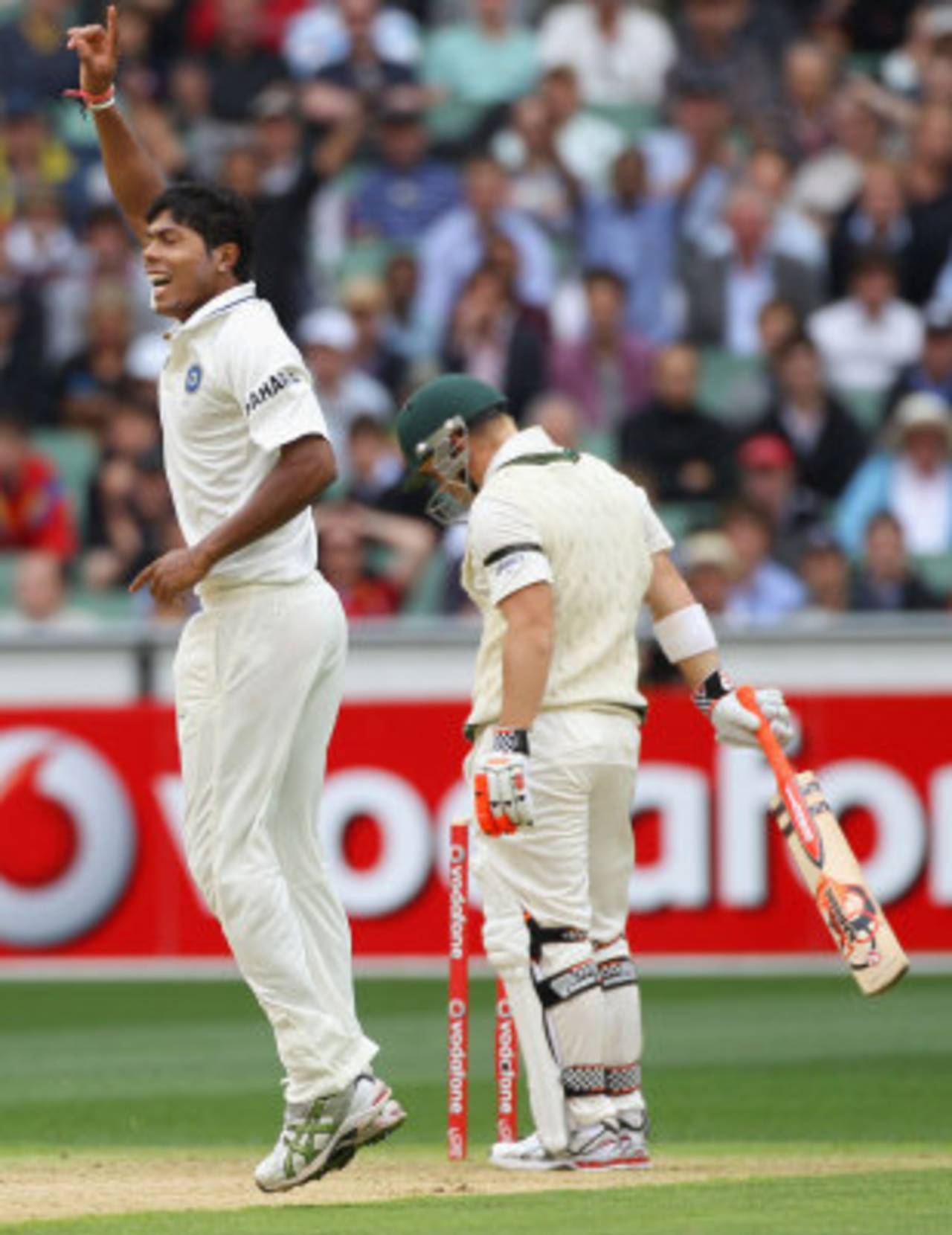Not a bad first day for poor starters
It was a day when both teams' weaker suits - Australia's batting and India's bowling - came face to face, and India didn't come out looking out of place
Sidharth Monga at the MCG
26-Dec-2011

Umesh Yadav got David Warner with a quicker bouncer. That is a rare sight for an India quick • Getty Images
On long hard tours, you need days when you are not at your best but come out unscathed. India had one of those days today. It is not to say that India didn't create opportunities, but there were also spells where they lacked inspiration.
In England every such day left them with scars. On the contrary, here they have the opposition at 6 for 277 after they had chosen to bat first on a slow track that had its moments, a bit like the India attack. It's a score India can be happy about after a wayward middle session when they dished up too many short deliveries. It's also a score that will irk them after they had had Australia down at 6 for 214. It's a score the significance of which depends a lot on how their bowlers, fresh on the second morning, do with a ball that is only nine overs old.
This wasn't a day of the spectacular for India. Zaheer Khan operated within himself in the first spell, letting debutant Ed Cowan leave a lot of balls, at the same time troubling the more adventurous David Warner. He was ordinary in the second spell, bowling bouncers to Ricky Ponting at gentle pace, but the thing about Zaheer is, you cannot feel sure about him until he has bowled his last over of the day. His burst late in the day, when he got the ball to move away from Michael Clarke, from round the stumps, with a 64-over old ball, following it up with two wickets in two deliveries, was reminiscent of the World Cup tie against England where he turned an ordinary night around in two overs. The absence of the Decision Review System notwithstanding, that 65th over was acknowledged later by Cowan too.
Umesh Yadav is fast emerging as an impact bowler. He can go for runs because he bowls quick and attacks the stumps, but he can produce wicket-taking deliveries purely with his pace. These are early days in Yadav's career, but the signs are good. Today he was the first to break the non-violence pact between the bowlers and openers. He was the first bowler Cowan and Warner took on. He was the first to make inroads.
Two balls after Warner had dismissively pulled him over midwicket for a six, Yadav came back with a quicker bouncer, beating the batsman for pace. That is a rare sight for an India quick, and it came in front of 70,000. That ended a 46-run first-wicket stand, but the pricklier partnership was the one for the third wicket, worth 113, when Australia could sense they were running away. Back came Yadav, from the Members End this time, and had a well-settled Ponting inside three deliveries. Again it was pace and bounce that left Ponting uncertain, and pace and slight seam that took the edge.
Facing the press after the day, Yadav seemed more nervous in front of about 30 people than when he worked Ponting out in front of 70,000. He said he tried to bowl fuller than he does in India, and he would have preferred to go for fewer runs. Ishant Sharma went for fewer, and not through defence. He actually was the pick of the India bowlers, pulling Australia back after runs flowed uncontrollably in the second session. He bowled with most control, and looked the most threatening. That he got no wickets keeps in with the script of the day.
India still had a chance to come out of the first day as clear leaders after that Zaheer burst, but MS Dhoni welcomed Brad Haddin with a long-on, deep midwicket, and fine leg, a field setting that suggests 5 for 400 and not 5 for 205. Haddin and Peter Siddle got the space to breathe, and ensured not a wicket fell for 21.5 overs. The criticism of such captaincy is obvious, but these moves are not thoughtless.
India's is a four-man attack, it was a long day, and in such situations at 6 for 214, Dhoni prefers to come back at 6 for 260 as opposed to 8 for 310 in an attempt to bowl them out for 250. That's how modern captains work, and we aren't exactly running out of time in Tests nowadays. The bowlers will be fresh on the second morning, the ball still new, and India will have a second bite at the cherry.
It was a day when both teams' weaker suits - Australia's batting and India's bowling - came face to face, and India didn't come out looking out of place. For a side notorious for poor first days, India would have taken 6 for 277 with all six specialist batsmen gone had you offered them that at the start.
Sidharth Monga is an assistant editor at ESPNcricinfo